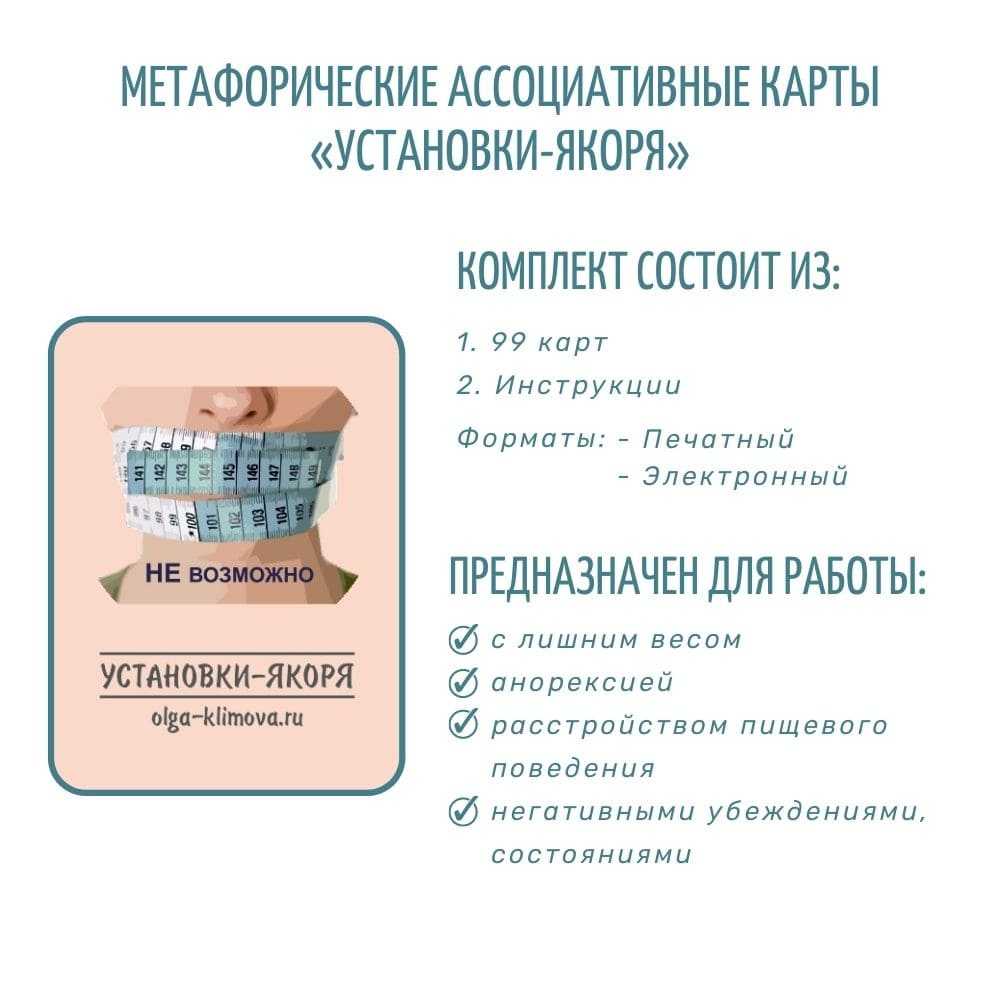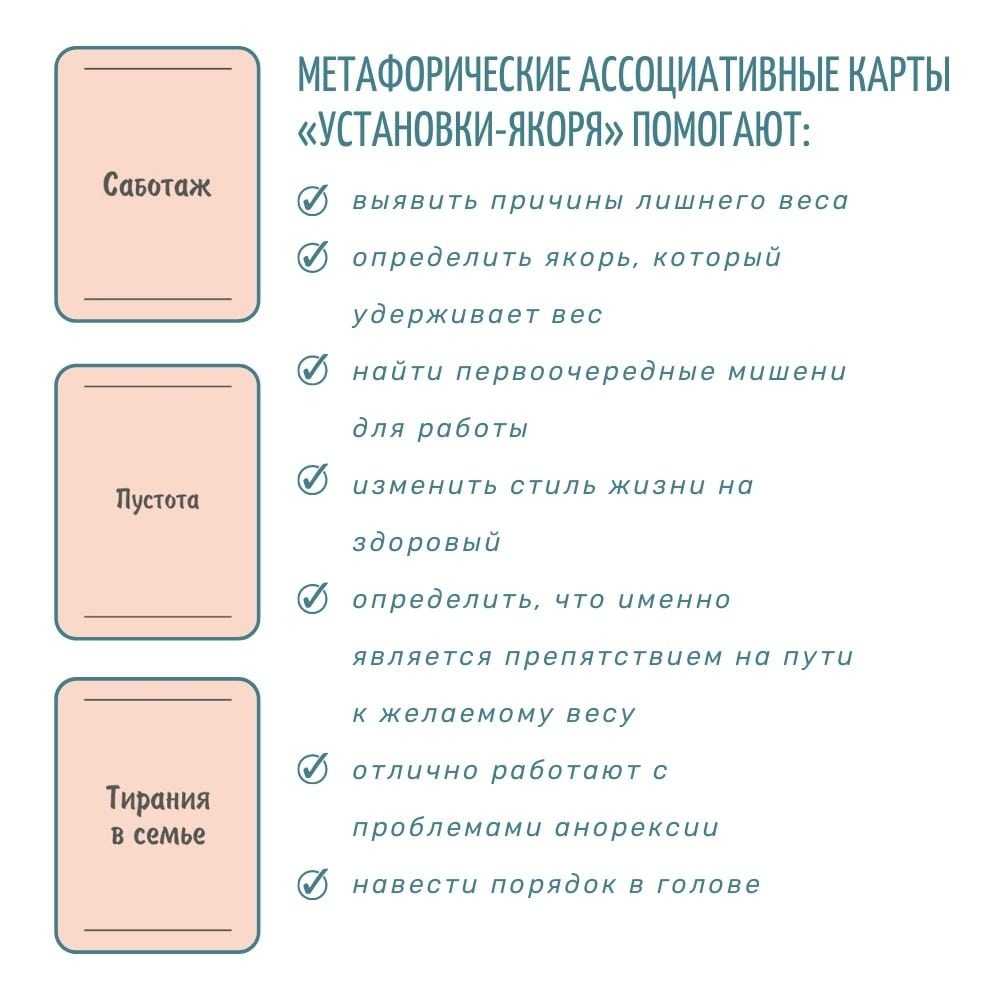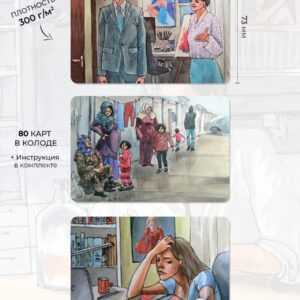The author of the deck is nbsp; Olga Vladimirovna Klimova is a clinical, perinatal psychologist. Regression hypnologist.nbsp;
Illustrator: Volkova Irina.
There are 99 cards in the deck.
Material: matte paper, paper density – 300 gm2, high print quality.
Packaging: cardboard box
Size: 88*58 mm
The deck was created for: psychologists-consultants, psychotherapists, art therapists, coaches, nbsp; gaming practitioners, leading transformational games, nutritionists, fitness consultants and people aimed at a healthy lifestyle.
Using this deck you can:
Ø Identify the causes of excess weight
Ø Find the reason that keeps the extra kg
p>
Ø Identify the main negative attitudes
Ø Understand what is the threat of excess weight
Ø Identify what you need to focus on in order to lose weight
Ø Will help you change an unecological lifestyle to a healthy one
Ø Find priority targets for work
Ø Work through negative attitudes, which are the anchors of excess weight
Ø Conduct coaching sessions about health
Ø and others..
The main goal of the deck is to bring to the surface hidden obstacles in the form of beliefs, states, behavior.
The “Anchor Installation” deck is an important integral part of the transformation game “Love Affair with the Refrigerator”
However, the deck can be used separately from the game, because it nbsp;has an independent a task aimed at freeing oneself from anchors and aimed at positive changes in relation to oneself, to the body and to weight.
As part of psychological counseling on the topic of psychocorrection of eating behavior, the psychologist often has to deal with the negative beliefs of clients.
This deck can safely be classified as diagnostic, clarifying, due to the fact that it allows a person to find his unconscious attitudes, which have a tremendous impact on healthy eating, weight and lifestyle.
Вnbsp; The deck includes not only psychological anchors, but also behavioral patterns.
Also with the help of this deck you can:
Ø find the obstacles that prevent you from changing your eating behavior
Ø understand , what to work on first
Ø realize how you feel about yourself and your body
Ø understand how much you love and accept yourself
Ø better understand yourself and your obstacles on the path to slimness
Ø understand what you need to pay close attention to
Ø in which direction to move to get slim
Ø in take a new look at yourself and your attitudes
Ø finally find a way out of the “fat dead end”
Exercise on nbsp;working with the “Anchor Attitudes” deck
1.nbsp;nbsp;nbsp;nbsp; As always, we begin with an immersion in metaphor, an invitation to a therapeutic dialogue. You give the client a deck of cards (face down, face down), with the words:
nbsp; – “now we will talk about your attitude towards yourself, towards your body, towards habits and attitudes that are anchors holding the weight.”
Ask the client to choose three cards.
2.nbsp;nbsp;nbsp;nbsp; Next, you need to open each card in turn and ask the following questions:
nbsp; (It is advisable for the client to write down the answers to the questions regarding “+-” himself immediately after the discussion, give him a few minutes and then move on to the next question.)
– How does this phrase apply to you?
– Where did she come from?
– Can you remember the first time you heard/felt this?
– What do you like about this judgment?
– Why don’t you like this judgment? and why?
– How exactly can he hold extra pounds?
– Why is it beneficial for you to have this installation?
– What resources (internal and external) do you lack? – here you can give additionally from any nbsp; resource deck of cards that will tell you what resources a person lacks at this stage to realize his desire.
– What resources (internal and external) do you already have?
– What do you feel now?
– How are you going to eliminate this belief? What specific three steps will you take over the next 72 hours? – here the client speaks out and draws up a step-by-step action plan and immediately writes it down.
Examples of additional questions:
– How is this attitude implemented in life?
– What is behind it?
– Who “gave it” to you? where is she from? How long ago?
– Is this anchor hindering or helping you in your life now?
– Is it possible to switch this anchor to another?
– What prevents you from getting rid of the anchor forever?
nbsp;And so on.
A lot of questions can and should be asked, in accordance with the client’s answers and in the context.
It is advisable not to rush into answers; sometimes the answer is enough for a person to fundamentally realize his problem.




















Reviews
Clear filtersThere are no reviews yet.